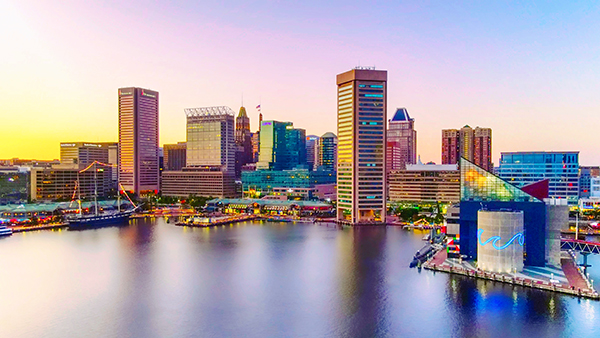Good morning, Baltimore!
Whatever your reference point for Baltimore—the Ravens and Orioles, steamed crabs, or the site of many John Waters movies (including Hairspray)—this close neighbor of Washington, D.C., has potential for investment you may not have considered.
Historically, Baltimore is where “The Star-Spangled Banner” was written during a siege of Fort McHenry in the War of 1812. Since then, its eclectic neighborhoods, unique style, culinary traditions, and mix of manufacturing, finance, commercial real estate, technology, and other employment sectors have earned it the nickname “Charm City.”
Just like everywhere else, it’s been a terrific market for real estate investing. Some investors have had a hard time finding properties (which has been a challenge for everyone in the industry), but with the assistance of local experts and advisers, opportunities remain. The forecast is very positive heading into 2022 as well.
Where Are the Opportunities?
When it comes to analyzing Baltimore for investment opportunities, many investors want insights into which neighborhood, which area, which region they should consider. The answer is that it’s very block to block, and every area has promise for improvement, new business, and renewal. Even in a very small two-block radius, there could well be a group of investors working together to bring about change. Overall, the market in the city is strong and robust.
Having said that, the significant price appreciation has emboldened those who want to retain properties for renting as opposed to quickly flipping them. They’re buying the property at a higher price. And maybe after the investment to rehab it, they are not seeing the profit they expected from a quick sale.
The thinking is that if they can generate cash flow on the property and if lenders like Trius Lending Partners can help refinance out of the short-term loan and into a 30-year-fixed at a low rate, that rental model starts to make sense. It may not be a quick flip, but they will see appreciation and income from the rental. That’s been a mindset and a shift that’s taking place in the area.
Growth and Demographics
A nice aspect about this market is that unlike larger cities such as Washington, D.C., or New York, Baltimore does not have huge market fluctuations. The rises and falls are more subtle, which is a positive for the market.
According to the Baltimore Development Corporation:
“Among major U.S. metros, Baltimore ranks ninth in downtown population and 12th in downtown employment, and has experienced rapid growth in the well-educated young-adult population.
“The city is home to 13 colleges and universities, including internationally recognized Johns Hopkins and University of Maryland-Baltimore. Professional sports teams, historic and cultural resources, and major employers in the health care, information and cybersecurity, finance and banking, and hospitality and entertainment industries also call the city home.
“More than 60 federal agencies and research labs are within 30 miles, bringing substantial federal spending and jobs to the city. Johns Hopkins Hospital and University is the largest recipient of federal research dollars nationally. Baltimore also has two state-of-the-art biotechnology business parks and numerous other business and industrial parks.”
The Baltimore metropolitan area, which includes Baltimore City and several surrounding counties, has grown from 2.6 million in 2000 to 2.8 million today. During that same time, population in the state of Maryland grew from 5.2 million to 6.2 million.
Due to its proximity to Washington, D.C., serving as the home to federal agencies, including the Social Security Administration and Centers for Medicare and Medicaid services, Baltimore is home to more than 10,000 federal government jobs. Other large employment sectors include the private sector (265,000), state government (34,000), education and health services (100,000), and construction/manufacturing (21,000).
The average weekly wage is $1,200.
The total civilian labor force is 1.2 million. More than 100,000 commute outside the area.
Housing prices in many parts of the city are well within reach of many families and are significantly lower than many surrounding counties and the Washington, D.C., market, making Baltimore attractive to potential new residents.
Why Baltimore Stands Apart from Other Cities
A differentiator between Baltimore and other cities is that it has a lower barrier to entry for investors than cities such as New York, Miami, Austin, and Dallas. Some investors who recently graduated college started buying single properties five years ago, and now they are buying more. They can’t do that in big cities. That’s what makes Baltimore valuable in this region: It is attractive to investors initially because of the affordability and then, as noted earlier, there is still a strong rental market.
Baltimore makes headlines sometimes for the wrong reasons, plagued as it is with many of the same challenges facing other midsize and big cities in the U.S. Certainly, the pandemic hasn’t helped.
And yet Baltimore’s charms remain. It will always be situated by the beautiful and resource-rich Chesapeake Bay, with immediate access to Washington, D.C.; New York; Philadelphia; and the entire mid-Atlantic region.
Not so long ago, Baltimore and its Inner Harbor were a national model for urban renewal and redevelopment. The design and downtown footprint of the Camden Yards baseball stadium has been replicated in cities across the county. There’s every reason to believe, from an investment point of view, that Baltimore will take back that position of leadership. Investors who get involved today will have more to benefit from.
Josh Shein is a real estate financing expert with nearly 20 years of lending experience. He is a partner with Trius Lending Partners, a private lender, helping real estate investors access direct funding for the purchase, renovation, or new construction of single-family, multifamily, and mixed-use properties throughout the mid-Atlantic, including Maryland, Delaware, Virginia, and D.C.
Shein brings a range of entrepreneurial and corporate expertise, holding executive roles at national Top 10 lenders. He is frequently called upon by national and trade news media to provide insight regarding mortgage industry trends and legislation, and he has repeatedly been selected to the “Hot 100” list by Mortgage Professional America (MPA).






















0 Comments